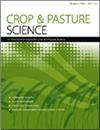Biochar increases soil enzyme activities in two contrasting pastoral soils under different grazing management
IF 1.9
4区 农林科学
Q2 AGRICULTURE, MULTIDISCIPLINARY
引用次数: 4
Abstract
ABSTRACT Context. Soil enzyme activities are key regulators of carbon and nutrient cycling in grazed pastures. Aims. We investigated the effect of biochar addition on the activity of seven enzymes involved in the carbon, nitrogen and phosphorus cycles in a Sil-andic Andosol and a Dystric Cambisol under permanent pastures. Methods. The study consisted of a one-year field-based mesocosm experiment involving four pastures under different nutrient and livestock practices: with and without effluent under dairy cow grazing on the Andosol, and with either nil or high phosphorus fertiliser input under sheep grazing on the Cambisol. Soil treatments were: (1) willow biochar added at 1% w/w; (2) lime added at the liming equivalence of biochar (positive control); (3) no amendments (negative control). Key results. Compared with the Cambisol, the Andosol had higher dehydrogenase, urease, alkaline and acid phosphatase and, especially, nitrate-reductase activities, aligning with its higher pH and fertility. In both soils, biochar addition increased the activity of all enzymes, except for acid phosphatase and peroxidase; lime addition increased peroxidase and nitrate-reductase activity. Conclusions. The increased enzyme activity was strongly positively correlated with soil biological activity following biochar addition. Biochar caused a 40–45% increase in cellulase activity, attributed to increased root biomass following biochar addition. The response in acid and alkaline phosphatase activity can be attributed to the impact of biochar and lime addition on soil pH. Implications. The results provide more insights in realising the potential benefits of biochar to the provision of ecosystem services for grazed pastures.在两种不同的放牧管理下,生物炭提高了土壤酶活性
抽象的上下文。土壤酶活性是放牧草地碳和养分循环的关键调控因子。目标研究了永久牧场下添加生物炭对silan - Andosol和Dystric Cambisol中参与碳、氮、磷循环的7种酶活性的影响。方法。该研究包括为期一年的野外中生态试验,涉及四个牧场,采用不同的营养和牲畜做法:在Andosol放牧奶牛的情况下,有和没有排放,在Cambisol放牧绵羊的情况下,无磷或高磷肥料投入。土壤处理:(1)添加1% w/w的柳树生物炭;(2)按生物炭石灰化当量添加石灰(阳性对照);(3)无修正(负控制)。关键的结果。与Cambisol相比,Andosol具有更高的脱氢酶、脲酶、碱性和酸性磷酸酶,特别是硝酸盐还原酶活性,这与其较高的pH和肥力相一致。在两种土壤中,添加生物炭均提高了除酸性磷酸酶和过氧化物酶外的所有酶的活性;添加石灰可提高过氧化物酶和硝酸还原酶活性。结论。添加生物炭后,土壤酶活性与土壤生物活性呈极显著正相关。生物炭使纤维素酶活性增加40-45%,这是由于添加生物炭后根生物量增加所致。酸性和碱性磷酸酶活性的响应可归因于生物炭和石灰添加对土壤ph的影响。这些结果为实现生物炭对放牧牧场提供生态系统服务的潜在好处提供了更多的见解。
本文章由计算机程序翻译,如有差异,请以英文原文为准。
求助全文
约1分钟内获得全文
求助全文
来源期刊

Crop & Pasture Science
AGRICULTURE, MULTIDISCIPLINARY-
CiteScore
4.20
自引率
15.80%
发文量
111
审稿时长
3 months
期刊介绍:
Crop and Pasture Science (formerly known as Australian Journal of Agricultural Research) is an international journal publishing outcomes of strategic research in crop and pasture sciences and the sustainability of farming systems. The primary focus is broad-scale cereals, grain legumes, oilseeds and pastures. Articles are encouraged that advance understanding in plant-based agricultural systems through the use of well-defined and original aims designed to test a hypothesis, innovative and rigorous experimental design, and strong interpretation. The journal embraces experimental approaches from molecular level to whole systems, and the research must present novel findings and progress the science of agriculture.
Crop and Pasture Science is read by agricultural scientists and plant biologists, industry, administrators, policy-makers, and others with an interest in the challenges and opportunities facing world agricultural production.
Crop and Pasture Science is published with the endorsement of the Commonwealth Scientific and Industrial Research Organisation (CSIRO) and the Australian Academy of Science.
 求助内容:
求助内容: 应助结果提醒方式:
应助结果提醒方式:


